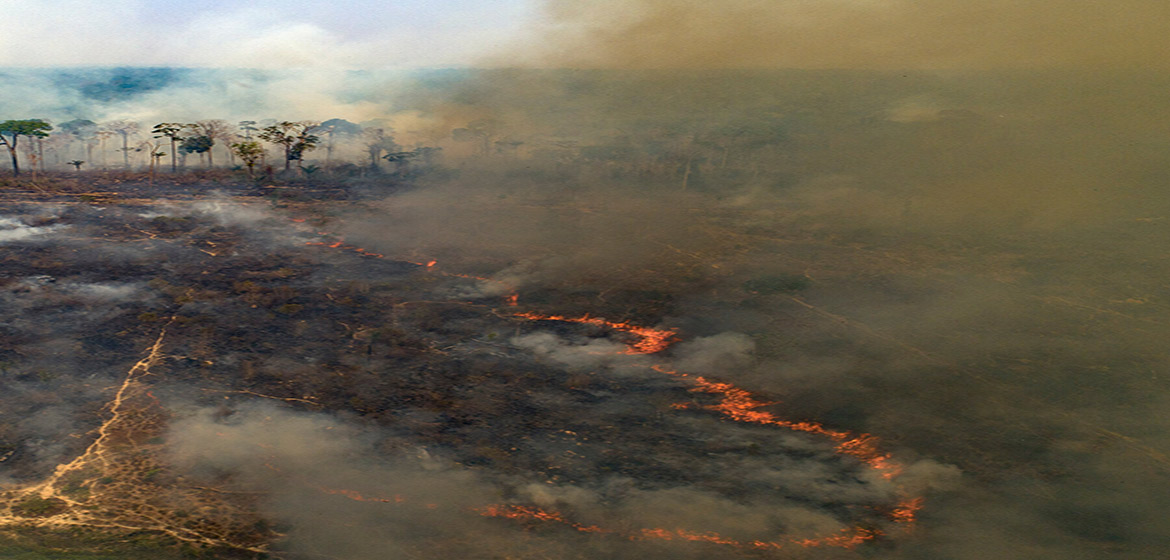The world can learn from indigenous peoples’ collective and practical response to climate change.
By Marcia Nunes Macedo and Valéria Paye Pereira
Dr. Macedo is an ecologist and climate scientist. Ms. Paye, of the Kaxuyana people, is a policy expert and activist based in Brazil.
“There’s a lot of land for few Indians.” So goes the tired creed, recently by President Jair Bolsonaro of Brazil. And yet those “few Indians,” representing 305 Indigenous groups and speaking 274 languages, have accomplished what governments have tried and failed to do for decades: control deforestation in more than 440,000 square miles of Amazon forests.
Indigenous people manage about half of the Brazilian Amazon, and year after year their lands have experienced the in the region. But lately, Indigenous people’s work has gotten harder, as the government has failed to enforce constitutional protections of their rights to the land. Illegal loggers, land grabbers, gold miners and drug traffickers are penetrating even deeper into the forest, now under the cover of a pandemic.
![]()
An illegal mine in Yanomami territory in Roraima, Brazil. Credit... Rogerio Assis/Instituto Socioambiental
![]()
Illegal tree-cutting in Roraima. Credit... Felipe Werneck/Ibama, via Associated Press
As a result, in just the first eight months of this year, of forest were cleared — which will eventually add around 226 million metric tons of carbon dioxide to the atmosphere — and more than 10,000 fires smothered the region in a blanket of smoke.
Indigenous peoples have maintained the Amazon for millenniums. They can keep doing so, if we let them.
For the Kuikuro people in the Xingu Indigenous Territory, the past provides clues about how to manage megafires, like the one that burned . Wildfires were not part of the recent memory of the Kuikuro, but archaeologists have unearthed evidence of strategies they used to control wildfires during the Medieval Warm Period, early in the last millennium. Complex earthworks — ditches, roads and dikes may well have been designed as firebreaks.
Today they have organized fire brigades that train and coordinate with Prevfogo, a government program to prevent and combat illegal fires. Although these partnerships have proved effective, firefighting efforts are threatened by deep cuts in federal funding for environmental agencies.
![]()
A Prevfogo firefighter. Credit... Fernando Bizerra Jr/EPA, via Shutterstock
The state, which represents 35 Indigenous territories in the north, provides another compelling example of leadership on climate change. It has trained local people to use digital mapping tools to gather data on natural resources and recorded how local populations were experiencing and responding to climate change using a cellphone app called . The effort culminated in the development of detailed plans on how to use resources responsibly and combat climate change in each territory.
Such practical, collective approaches could be applied to many other challenges, like managing emerging diseases. The Kuikuro did mount a rapid response to Covid-19, using cellphones to trace contacts and quarantine the infected in six villages. They also ran an online campaign to hire doctors and nurses and buy supplies, virtually eliminating the need for travel to nearby cities. These decisive interventions paid off: almost no Covid-19 deaths have been reported there.
Instead of learning from Indigenous people, the Brazilian government has left them out of discussions about how to manage their own territories. It continues to treat them as “wards of the state” rather than people with the simple right to occupy their land and maintain their way of life. The international community has followed Brazil’s lead. Indigenous people, for example, remain nonvoting “observers” of the negotiations surrounding the United Nations Framework Convention on Climate Change.
![]()
Members of the Tapirape tribe in Mato Grosso were among those who gathered in January to challenge President Bolsonaro’s environmental policy. Credit... Carl De Souza/Agence France-Presse — Getty Images
But Indigenous people have demanded a seat at the table. The Coordination of the Indigenous Organizations of the Brazilian Amazon was among the first groups to send Indigenous delegates from Brazil to UN climate talks. Indigenous leaders, many of them women like Sineia do Vale of the Wapichana people, spoke directly to world leaders and reported back to their communities. They have organized an impressive Pan-Amazon coalition that spans the region’s nine countries to raise awareness about the challenges facing Indigenous people and their contributions to combating the climate crisis.
The world can’t afford to keep treating Indigenous people this way. The forests of the Amazon could absorb up to 10 percent of global carbon dioxide emissions each year. Its trees store the carbon equivalent of 10 years of global emissions. By ignoring what Indigenous people know about how to protect their forests, we lose potential solutions to the climate crisis. We lose time and we lose money. It is unstrategic and unethical.
It will also make it impossible for Brazil to meet its climate commitments. This year, deforestation is already double the 2020 limit set under Brazil’s National Climate Change Plan.
The future of tropical forests, and the future global climate, are indelibly tied up in guaranteeing the rights of Amazon Indigenous people to their land and livelihoods. Defending their territories protects their social and cultural rights. But it also conserves natural ecosystems that are critical for the well-being of all people.
Source:
Related to SDG 10: Reduced inequalities and SDG 16: Peace, justice and strong institutions



